What many may not realize is the full extent of the role today’s temporary equipment providers can play in helping to meet goals and bring projects to successful completion.
By getting acquainted with the full scope of equipment, services, and solutions available from large vendors, you can discover new ways to increase safety, productivity, and sustainability.
Temporary power is a must-have for off-grid and remote job sites. Contractors can rent everything from portable diesel generators to industrial mobile generators from the same company that supplies their excavators and aerial lifts. They can also take advantage of remote monitoring to check the fuel status of each generator.
Safety and security are essential to success. Rental options include smart turnstiles, ignition keypad locks installed on equipment, storage containers with interior locking rods, and wearable devices.

| Your local Gomaco dealer |
|---|
| Terry Equipment |
For example, they can offer custom-stocked proboxes and tool trailers so crews have easy access to the tools they need to get the job done without interruption. Managed tool trailers and smart proboxes offer additional benefits: They help companies track tools and tool utilization, reducing tool loss and over-tooling.
Some vendors offer inventory-on-demand trailers — stocked with anything from tools to parts to PPE — that allow employees to enter job cost codes for job cost allocation.
Rental providers with expertise in dewatering and trench systems also offer technical guidance and site-specific solutions. For example, they can design a dewatering system that maximizes efficiency and may eliminate rework and generate cost savings. A turnkey provider will even perform the installation on request.
An equipment partner that has in-house registered Professional Engineers can provide custom-engineered trench safety solutions when needed. If the depth of an excavation, the soil conditions, or surcharges exceed the design parameters outlined in the manufacturer’s tabulated data, a custom-engineered solution is necessary. An equipment partner can create a site-specific design using rental equipment and customer-owned equipment.
Specialty equipment and expertise also come into play when contractors are required to filter groundwater for contaminants before releasing it into a body of water. A rental partner can advise on whether filtration is required. If it is, they can provide the advice, equipment, and onsite support to help ensure the job is done right.
Rental companies that offer equipment maintenance can take over the maintenance and inspection of owned equipment, either on-demand or onsite, freeing contractors to focus on their core business.
Renting is a smart way to try the newest equipment, including alternatively powered equipment that reduces fossil fuel consumption and minimizes or eliminates greenhouse gas emissions. Vendors that carry electric and hybrid equipment can advise on run times and the best charging options based on grid availability and work schedules.
Rental inventories may include alternatively fueled generators and battery energy storage solutions (BESS). Pairing a generator with a BESS significantly reduces generator runtime, cutting fuel consumption by as much as 80 percent and emissions by up to 50 percent.
However, the best way to reduce emissions isn’t always by leveraging a different piece of equipment. Rental providers help contractors identify the biggest opportunities for improvement, which may include switching to renewable diesel fuel.
Another way to reduce fuel consumption and emissions is through remote environmental monitoring. Often, job site heaters run 24/7. Rental providers may offer remote environmental monitoring solutions. Contractors can configure alerts that notify them via text or email when the ambient temperature or humidity exceeds predetermined thresholds. They can then adjust the heater’s thermostat — remotely, in some cases — so the heater doesn’t run when it doesn’t need to.
One of the more challenging aspects of reducing job site emissions is tracking them. Digital tools offered by some rental equipment vendors extend to dashboards that calculate emissions based on telematics data and the type of fuel used. Some dashboards even show which equipment and which job sites are generating the most emissions.
Platforms available from large rental partners allow contractors to run utilization reports on telematics-enabled equipment in order to optimize utilization and right-size fleets. These platforms enable solutions such as tool tracking, remote monitoring of equipment and environmental conditions, and customizable diagnostic alerts that facilitate equipment maintenance.
The most robust software platforms form the basis of a fully connected job site. Connected job sites can automate and seamlessly integrate two critical aspects of safety and security: perimeter access management and equipment access management. They may allow the same RFID-enabled worker ID badges to authenticate entrants at smart turnstiles and at equipment ignition locks when card readers are added to the locks by the rental provider.
Digital access management tools reduce the burden of manually checking badges at entry points and assigning unique PIN codes to dozens of equipment operators.
A rental equipment vendor can help contractors evaluate job site and project needs and suggest digital solutions that fit the budget and deliver tangible results.
By talking with a full-service rental equipment vendor well before a job starts, contractors can learn about their offerings and decide what equipment, services, and solutions will benefit their project.






































































